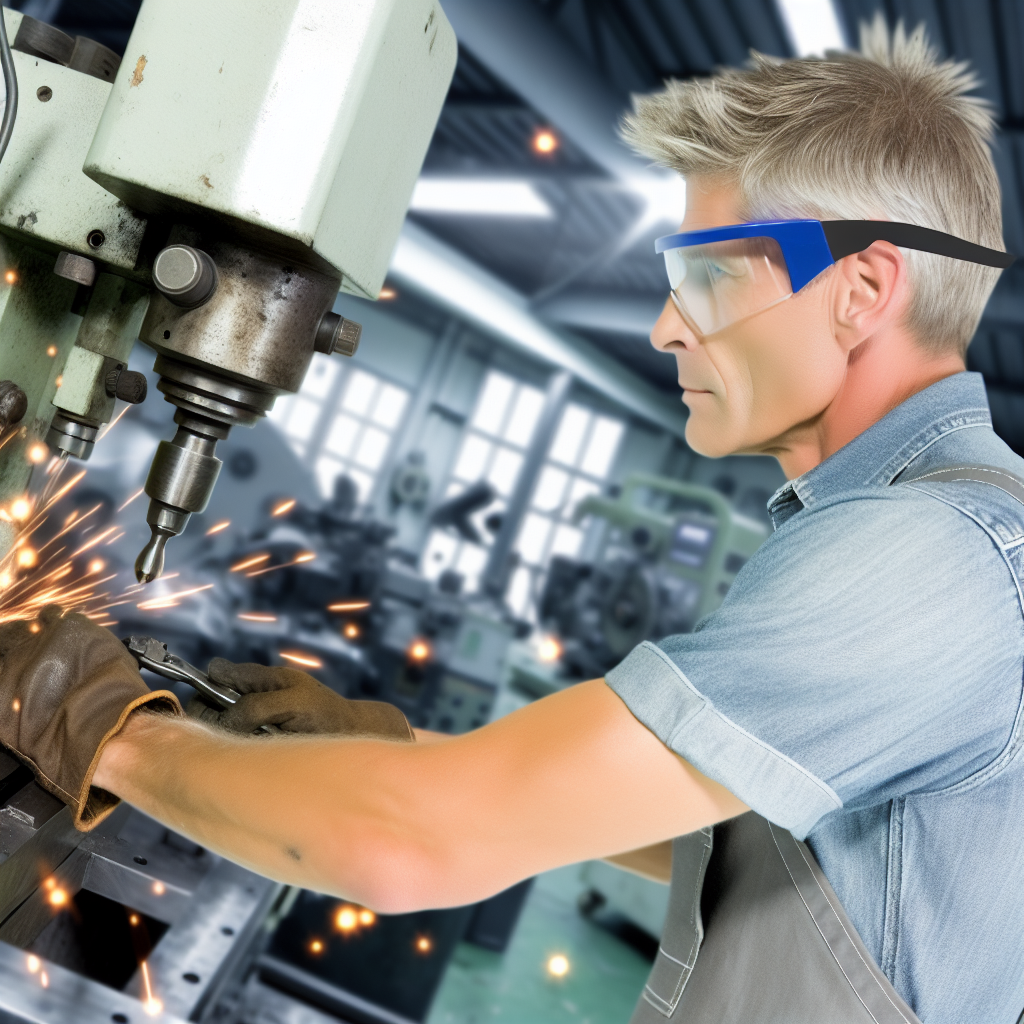Introduction
In the field of machining, having the right tools is crucial for precision and efficiency.
The top 5 machinist tools play a significant role in various tasks such as cutting, shaping, and finishing metal and other materials.
Using the appropriate tools for specific machining tasks is essential to achieve accurate results and ensure safety.
The tools that will be discussed in this blog post are essential for machinists to perform their job effectively and efficiently.
Now, let’s delve into the top 5 machinist tools and explore their uses in detail.
Calipers
Calipers are used for measuring distances between two points accurately.
There are different types of calipers such as Vernier calipers, dial calipers, and digital calipers.
Calipers provide high precision and accuracy in machining applications.
Calipers are an essential tool for machinists as they allow precise measurements to be taken in various machining tasks.
These measuring tools are versatile and can be used for a wide range of applications.
Let’s delve deeper into the uses of calipers in machining and the different types available.
Vernier Calipers
Vernier calipers are a type of caliper that offers high accuracy in measuring distances.
They consist of two jaws, one fixed and one movable, that can be adjusted to measure the dimensions of an object.
The Vernier scale allows for more precise readings compared to a standard ruler.
Dial Calipers
Dial calipers feature a dial indicator for measurements, making it easier to read measurements compared to traditional calipers.
They provide accurate readings and are commonly used in machining applications where precision is crucial.
Digital Calipers
Digital calipers have a digital display that shows measurements in decimal form, making them easier to read and eliminating the need for manual interpretation.
They are widely used in modern machining due to their convenience and accuracy.
Regardless of the type of caliper used, these tools are known for their precision and accuracy in measuring distances and dimensions.
Machinists rely on calipers to ensure the accuracy of their work and to achieve precise results in their machining projects.
Transform Your Career Today
Unlock a personalized career strategy that drives real results. Get tailored advice and a roadmap designed just for you.
Start NowMicrometers
Micrometers play a critical role in the field of machining.
They enable machinists to measure small distances with utmost precision.
Types of Micrometers
- Outside Micrometers: Used to measure the external diameter of objects such as shafts, rods, etc.
- Inside Micrometers: Designed for measuring the internal diameter of holes or bores.
- Depth Micrometers: Specifically used to measure the depth of holes, slots, or any other depressions.
Each type of micrometer serves a specific purpose.
They ensure accurate measurements in various machining applications.
Precision Measurement
Micrometers are highly precise instruments used in machining processes.
Even the smallest deviations can impact the final product.
By utilizing micrometers, machinists can guarantee the exact dimensions required for a particular component.
This ensures its functionality and quality.
Whether it’s measuring the thickness of a material or the diameter of a hole, micrometers provide accurate readings down to a fraction of a millimeter.
The ability to measure with such precision is essential in machining.
Components need to fit together with tight tolerances.
With micrometers, machinists can maintain the desired specifications.
This results in parts that perform optimally within a given system.
Micrometers are indispensable tools in the machinist’s arsenal.
They allow the highest level of accuracy and quality in work.
Discover More: Tips for Successful Construction Project Planning
Dial Indicators
Dial indicators are precision measuring tools used in machining to measure small linear distances and angles accurately.
These indicators are mounted on machines using clamps, magnetic bases, or other attachments to detect variations in part dimensions.
Dial indicators play a crucial role in aligning machine components such as gears, shafts, and workpieces to ensure proper tolerances.
Showcase Your Business Today
Reach thousands of readers actively exploring professional services. Publish your business profile and grow your audience now.
Publish NowBy using dial indicators, machinists can check for runout, alignment, and concentricity of various machine parts during the manufacturing process.
These tools are commonly used in conjunction with other measuring instruments such as micrometers and calipers to achieve precise and accurate measurements.
Operating a dial indicator involves adjusting the needle to zero, moving the contact point to the desired surface, and reading the measurements on the dial scale.
Machinists rely on dial indicators to ensure the quality and precision of their work, especially in tasks that require tight tolerances and exact measurements.
Using dial indicators correctly can help machinists identify defects, deviations, or inaccuracies in machined parts before they cause any production issues.
Overall, dial indicators are indispensable tools in the machinist’s arsenal, helping them maintain high levels of accuracy and consistency in their work.
Uncover the Details: The Role of Assemblers in the Automotive Industry
Deburring Tools
Deburring tools play a crucial role in the machining process by removing burrs and sharp edges from machined parts.
Burrs are unwanted pieces of material that are left behind after a workpiece is machined.
If not removed, they can affect the performance and aesthetics of the final product.
Types of Deburring Tools:
- Hand Deburring Tools: These are handheld tools that are manually operated to remove burrs from small, intricate parts.
- Deburring Blades: These are thin, sharp blades that are used to shave off burrs from edges of machined components.
- Deburring Machines: These are automated machines that are designed to efficiently remove burrs from a large volume of parts in a short amount of time.
Role of Deburring Tools:
Deburring tools are essential for enhancing the quality and functionality of machined components.
By eliminating burrs and sharp edges, these tools ensure that parts fit together properly.
This reduces the risk of injury and improves the overall performance of the machine.
Additionally, deburring tools help to achieve precise dimensions and tolerances.
This leads to a more polished and professional final product.
Delve into the Subject: The Evolution of Machining Technology Over Time

Thread gauges are essential tools used in the machining industry to check the accuracy of screw threads.
They play a crucial role in ensuring that threaded components fit and function properly.
Types of Thread Gauges
- Ring Gauges
- Plug Gauges
Ring gauges are used to measure the external threads, while plug gauges are used for internal threads.
Both types of gauges come in various sizes to accommodate different thread specifications.
Importance of Thread Gauges
Thread gauges help machinists verify the pitch, diameter, and depth of threads accurately, ensuring they meet the required specifications.
By using thread gauges, manufacturers can maintain consistent quality standards for threaded components, reducing the risk of defects.
Thread gauges ensure that threaded parts from different manufacturers can be easily interchanged without compatibility issues.
Checking threads with gauges is a quick and efficient process, saving time during production and assembly.
By preventing the use of incorrect or faulty threads, thread gauges help reduce the overall cost of production and maintenance.
Thread gauges are indispensable tools in the machinist’s arsenal, playing a vital role in ensuring the precision, quality, and efficiency of threaded components in various industries.
Explore Further: Surveyor Skills: Key Competencies for Success
Importance of Top Machinist Tools
The top 5 machinist tools play a crucial role in enhancing efficiency.
They ensure precision in machining processes.
Utilizing the right tools ensures accurate results.
High-quality output is a direct benefit.
It is essential to prioritize precision when choosing tools.
Accuracy impacts the overall quality of the process.
Improving the final product is a key outcome.
Streamlining the manufacturing process is also important.
I encourage readers to invest in high-quality machinist tools.
Such investments directly impact efficiency and productivity.
Using the right tools helps achieve better results in less time.
Minimizing waste is a significant benefit of proper tool selection.
Additional Resources
Americans with Disabilities Act of 1990, As Amended | ADA.gov
Showcase Your Business Today
Reach thousands of readers actively exploring professional services. Publish your business profile and grow your audience now.
Publish NowHome : Occupational Outlook Handbook: : U.S. Bureau of Labor …
[E-Books for Sale]
The Big Book of 500 High-Paying Jobs in America: Unlock Your Earning Potential
$19.99 • 500 High-Paying Jobs • 330 pages
Explore 500 high-paying jobs in America and learn how to boost your career, earn more, and achieve success!
See All 500 High-Paying Jobs of this E-Book
1001 Professions Without a Degree: High-Paying American Jobs You Can Start Now
$19.99 • 1001 Professions Without a Degree • 174 pages
Discover 1001 high-paying jobs without a degree! Unlock career tips, skills, and success strategies for just $19.99!




